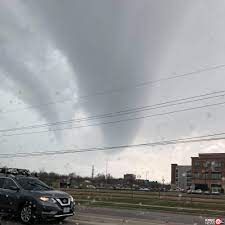Lessons From Leawood: The Tornado of June 8
Even a small tornado can provoke big thoughts

LEAWOOD, Kan.—As tornados go, it was rather puny. Then again, a piece of debris striking someone at 100 mph—the wind determined for that particular EF-1 twister—could kill or cause severe injury.
But this column isn’t about the tornado per se. Rather it’s about the experiences of some of the people in my hometown during the event, public safety warnings and NextGen TV.
First some basics. The tornado formed at about 1 a.m. on June 8, roughly seven miles west of my neighborhood in the city of Lenexa, Kan., and traveled east along a major thoroughfare. By the time it got to about a half mile from my house it was no wider than 125 yards. Continuing east into Missouri, the twister traveled along a path from Kansas City, Mo., to the northeast side of a major interstate intersection called the “Grandview Triangle” where it dissipated. No deaths or injuries were reported.
I was out of town at the time, but my wife reports being sound asleep when a warning tone emanated from her smartphone. Groggy, she assumed it was an Amber Alert, which too often comes in waves about events far away. She then rolled over and went back to sleep, not hearing Johnson County’s tornado sirens—although they functioned properly.
Across the street, my neighbors say they slept through the entire event and didn’t learn of it until the next day. Next door, the neighbors heard the sirens and headed to the basement.
The young man who cuts my grass and lives about a block closer to the twister’s path, heard the alert on his phone and the county’s sirens. He went outside to take a look, determined it wasn’t a false alarm, went inside and headed to the basement. He reports losing cellular and internet service right about then.
I have learned a few lessons from this experience that might benefit broadcasters. First, the time of day an emergency happens plays a huge role in the effectiveness of efforts to warn the public. If people are asleep, some will keep right on sleeping.
Second, when a mobile phone frequently goes off with an Amber Alert warning—something that seems to happen in spurts about possible abductions many miles—its effectiveness as a tool to convey a warning wanes. It becomes background noise and is easily ignored, especially when someone is sleeping.
Third, layering warnings from broadcast, mobile phones and public sirens increases the chance that some members of the public, like the lawn guy, will receive a warning and take it seriously. In his case, two forms of warning prompted action.
Fourth, it’s human nature to want to confirm the legitimacy of an emergency warning like my lawn guy did by walking outside. John Lawson, executive director of the AWARN Alliance, on several occasions, has pointed out to me that one of the first things people do when they receive an emergency alert on their phones is to confirm that it’s real. Typically, they ping a website or call someone to confirm the legitimacy of the warning with the same smartphone. When thousands of people do this in a small footprint they are likely to overwhelm the nearby cell tower with traffic.
As for ATSC 3.0 at this point, it goes without saying that 3.0 advanced emergency warnings can “wake up” NextGen TVs in the homes of people living in the path of a tornado or some other emergency. I suspect that doing so stands a better chance of getting the attention of people as they snooze.
With this capability comes a weighty responsibility for broadcasters however. In an era of cost-cutting and workflow efficiency, will they have someone—not necessarily the station meteorologist—present or who has a hardened link back to the station from home at 1 a.m. to take advantage of this capability and warn people of an impending threat?
Lastly, waking up sets and targeting warnings based on geographical coordinates is great; however, if the public doesn’t own a NextGen TV or, worse yet, owns one and does not know about these capabilities and how to enable them on their end, what good are they?
Broadcasters must waste no time educating the public with PSAs and even by meeting with the people directly in their communities at civic gatherings to inform them of the advanced emergency warning capabilities of NextGen TV. Doing so is fully consistent with broadcasters’ public service obligation—not some self-serving promotional undertaking. It could also save the lives of someone they love.
Get the TV Tech Newsletter
The professional video industry's #1 source for news, trends and product and tech information. Sign up below.
Phil Kurz is a contributing editor to TV Tech. He has written about TV and video technology for more than 30 years and served as editor of three leading industry magazines. He earned a Bachelor of Journalism and a Master’s Degree in Journalism from the University of Missouri-Columbia School of Journalism.

